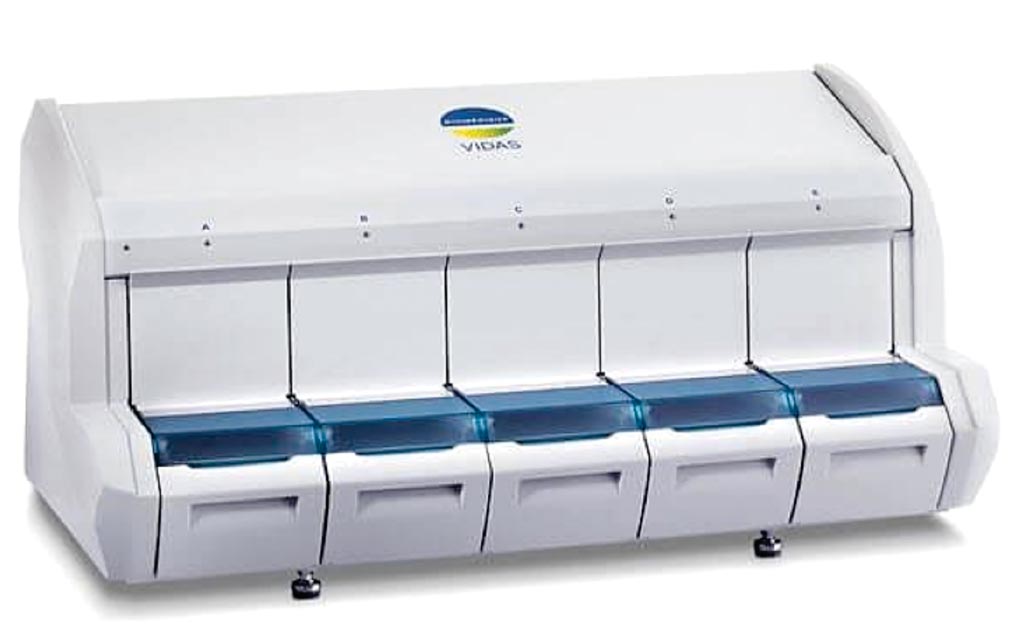Procalcitonin Guides Use of Antibiotics for Respiratory Infections
By LabMedica International staff writers
Posted on 12 Jun 2018
The overuse of antibiotic agents is a public health problem associated with increased health care costs and antibiotic resistance. Overuse of antibiotics is common in infections of the lower respiratory tract, where bacterial and viral infections manifest similarly.Posted on 12 Jun 2018
Procalcitonin is a peptide with levels that are more typically elevated in bacterial than in viral infections; the magnitude of the elevation correlates with the severity of infection, and decreasing levels over time correlate with the resolution of infection.

Image: The Vidas BRAHMS procalcitonin assay is performed on the benchtop Vidas multiparametric immunoassay instrument (Photo courtesy of bioMérieux).
Medical scientists at the University of Pittsburgh (Pittsburgh, PN, USA) enrolled adult patients (≥18 years old) in the emergency department for whom the treating clinician had given an initial diagnosis of acute lower respiratory tract infection (<28 days in duration) but had not yet decided to give or withhold antibiotics and about whom there was uncertainty regarding the need for antibiotics, such that procalcitonin data could influence the prescribing decision.
The team measured procalcitonin using a rapid assay with an analytic range of 0.05 to 200 μg/L. They randomly assigned patients who presented to the emergency department with a suspected lower respiratory tract infection and for whom the treating physician was uncertain whether antibiotic therapy was indicated to one of two groups: the procalcitonin group, in which the treating clinicians were provided with real-time initial (and serial, if the patient was hospitalized) procalcitonin assay results and an antibiotic use guideline with graded recommendations based on four tiers of procalcitonin levels, or the usual-care group.
The scientists included a total of 1,656 patients in the final analysis cohort (826 randomly assigned to the procalcitonin group and 830 to the usual-care group), of whom 782 (47.2%) were hospitalized and 984 (59.4%) received antibiotics within 30 days. The treating clinician received procalcitonin assay results for 792 of 826 patients (95.9%) in the procalcitonin group (median time from sample collection to assay result, 77 minutes) and for 18 of 830 patients (2.2%) in the usual-care group. In both groups, the procalcitonin-level tier was associated with the decision to prescribe antibiotics in the emergency department.
There was no significant difference between the procalcitonin group and the usual-care group in antibiotic-days (mean, 4.2 and 4.3 days, respectively; difference, -0.05 day); or the proportion of patients with adverse outcomes of 96 patients (11.7%) and the other 109 patients (13.1%); (difference, -1.5 percentage points, for noninferiority) within 30 days. In the analysis of secondary outcomes, there was no significant difference between the procalcitonin group and the usual-care group in the percentage of patients receiving any antibiotics within 30 days.
The authors concluded that the provision of procalcitonin assay results, along with instructions on their interpretation, to emergency department and hospital-based clinicians did not result in less use of antibiotics than did usual care among patients with suspected lower respiratory tract infection. The study was published on May 20, 2018, in the New England Journal of Medicine.
Related Links:
University of Pittsburgh




 assay.jpg)








